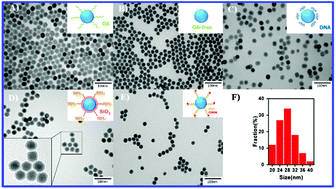Our official English website, www.x-mol.net, welcomes your feedback! (Note: you will need to create a separate account there.)
A versatile upconversion surface evaluation platform for bio–nano surface selection for the nervous system
Nanoscale ( IF 6.7 ) Pub Date : 2017-08-17 00:00:00 , DOI: 10.1039/c7nr03557h Libing Fu 1, 2, 3, 4, 5 , Marco Morsch 6, 7, 8, 9, 10 , Bingyang Shi 1, 2, 3, 4, 5 , Guoying Wang 6, 7, 8, 9, 10 , Albert Lee 6, 7, 8, 9, 10 , Rowan Radford 6, 7, 8, 9, 10 , Yiqing Lu 1, 2, 3, 4, 5 , Dayong Jin 10, 11, 12, 13, 14 , Roger Chung 6, 7, 8, 9, 10
Nanoscale ( IF 6.7 ) Pub Date : 2017-08-17 00:00:00 , DOI: 10.1039/c7nr03557h Libing Fu 1, 2, 3, 4, 5 , Marco Morsch 6, 7, 8, 9, 10 , Bingyang Shi 1, 2, 3, 4, 5 , Guoying Wang 6, 7, 8, 9, 10 , Albert Lee 6, 7, 8, 9, 10 , Rowan Radford 6, 7, 8, 9, 10 , Yiqing Lu 1, 2, 3, 4, 5 , Dayong Jin 10, 11, 12, 13, 14 , Roger Chung 6, 7, 8, 9, 10
Affiliation

|
There is considerable interest in developing diagnostic nanotools for early detection and delivery of various therapeutic agents for treatment of neurodegenerative diseases. However, a key challenge remains in the selection of suitable surfaces to overcome the nano–bio interface issue, namely that many nanoparticle surfaces demonstrate instability when administered into biological environments and show substantial cytotoxicity to the central nervous system. In this study, we fabricated an evaluation platform for bio–nano surface selection based on the combination of upconversion nanoparticles (UCNPs), cultured neural cells and zebra fish, and systemically demonstrated how it can evaluate the suitability of nanoparticle surfaces for applications in the central nervous system. Firstly, we fabricated highly lanthanide-doped UCNPs, which generate the strongest tissue penetrable emission at 800 nm. We then functionalized these UCNPs with four popular surfaces for evaluation. Next, we systematically evaluated the spectral emission properties, biophysical stability, cytotoxicity and cell uptake capability of these surface-functionalized UCNPs in biological solutions or with cultured NSC-34 cells. Through these studies, PEG-COOH proved to be the superior surface modification. Accordingly, we further confirmed the bioavailability of unmodified and surface modified UCNPs in the spinal cord of living zebrafish. As predicted, PEG-UCNPs displayed excellent dispersal and uptake into spinal motor neurons in living zebrafish. Collectively, this study developed a versatile upconversion platform for systematic evaluation of nanoparticle surfaces, which can provide valuable information via systemic surface evaluation in vitro and in vivo for future construction of multifunctional nanosystems for theranostic applications in neurodegenerative diseases.
中文翻译:

通用的上转换表面评估平台,用于神经系统的生物纳米表面选择
开发用于早期检测和递送用于治疗神经退行性疾病的各种治疗剂的诊断纳米工具具有相当大的兴趣。然而,关键的挑战仍然在于选择合适的表面来克服纳米生物界面的问题,即许多纳米颗粒表面在生物环境中给药时表现出不稳定性,并对中枢神经系统显示出实质性的细胞毒性。在这项研究中,我们基于上转换纳米颗粒(UCNP),培养的神经细胞和斑马鱼的组合,制造了用于生物纳米表面选择的评估平台,并系统地展示了它如何评估纳米颗粒表面在中央应用的适用性。神经系统。首先,我们制造了高度掺杂镧系元素的UCNP,在800 nm处产生最强的组织穿透性发射。然后,我们使用四个流行的表面对这些UCNP进行功能化以进行评估。接下来,我们系统地评估了这些表面功能化的UCNP在生物溶液或培养的NSC-34细胞中的光谱发射特性,生物物理稳定性,细胞毒性和细胞摄取能力。通过这些研究,PEG-COOH被证明是优异的表面改性。因此,我们进一步证实了未修饰的和表面修饰的UCNPs在活斑马鱼的脊髓中的生物利用度。如预测的那样,PEG-UCNPs在活斑马鱼中表现出出色的扩散和摄取到脊髓运动神经元的能力。这项研究共同开发了一种多功能的上转换平台,用于系统地评估纳米粒子表面,该平台可以提供有价值的信息通过体外和体内的系统表面评估,为将来在神经退行性疾病中用于治疗学应用的多功能纳米系统的构建提供帮助。
更新日期:2017-09-21
中文翻译:

通用的上转换表面评估平台,用于神经系统的生物纳米表面选择
开发用于早期检测和递送用于治疗神经退行性疾病的各种治疗剂的诊断纳米工具具有相当大的兴趣。然而,关键的挑战仍然在于选择合适的表面来克服纳米生物界面的问题,即许多纳米颗粒表面在生物环境中给药时表现出不稳定性,并对中枢神经系统显示出实质性的细胞毒性。在这项研究中,我们基于上转换纳米颗粒(UCNP),培养的神经细胞和斑马鱼的组合,制造了用于生物纳米表面选择的评估平台,并系统地展示了它如何评估纳米颗粒表面在中央应用的适用性。神经系统。首先,我们制造了高度掺杂镧系元素的UCNP,在800 nm处产生最强的组织穿透性发射。然后,我们使用四个流行的表面对这些UCNP进行功能化以进行评估。接下来,我们系统地评估了这些表面功能化的UCNP在生物溶液或培养的NSC-34细胞中的光谱发射特性,生物物理稳定性,细胞毒性和细胞摄取能力。通过这些研究,PEG-COOH被证明是优异的表面改性。因此,我们进一步证实了未修饰的和表面修饰的UCNPs在活斑马鱼的脊髓中的生物利用度。如预测的那样,PEG-UCNPs在活斑马鱼中表现出出色的扩散和摄取到脊髓运动神经元的能力。这项研究共同开发了一种多功能的上转换平台,用于系统地评估纳米粒子表面,该平台可以提供有价值的信息通过体外和体内的系统表面评估,为将来在神经退行性疾病中用于治疗学应用的多功能纳米系统的构建提供帮助。



























 京公网安备 11010802027423号
京公网安备 11010802027423号